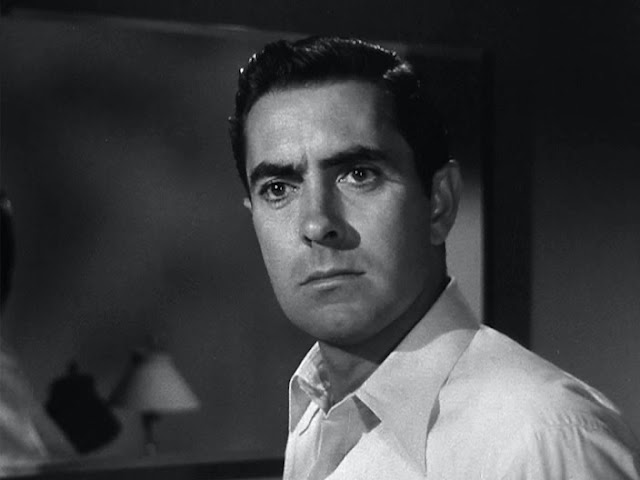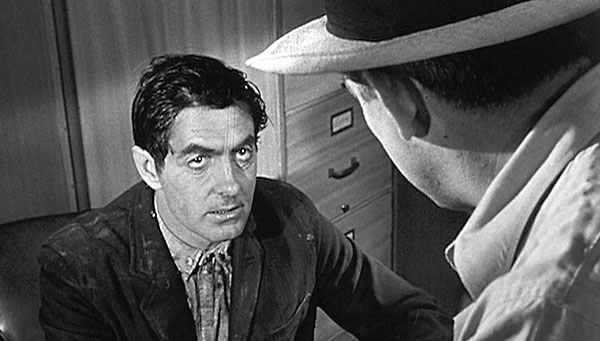 |
| Tyrone Power as Stan Carlisle, charismatic con man, in 1947's "Nightmare Alley." |
Tyrone Power became an instant star at 20th
Century Fox in 1936, in Lloyd’s of London.
Ty was their combination of Robert Taylor and Clark Gable. Studio head Darryl
F. Zanuck considered him their golden boy, and Ty was still a top star over two
decades later, when he died at 44 in 1958. At the peak of his stardom, Tyrone
Power pushed to make the bleak film noir, 1947’s Nightmare Alley.
 |
| Legend has it that studio head Darryl F. Zanuck placated top star Tyrone Power in making "Nightmare Alley," but basically dumped it upon release. |
In Nightmare
Alley’s opening carny scenes, Tyrone Power is slim and darkly handsome in
his white tee shirts, reminiscent of another young hustler on the make, Montgomery
Clift in 1951’s A Place in the Sun.
Though Power was an intelligent and sensitive actor, I think Tyrone was closer
to Rock Hudson in terms of image and talent. Clift played against his looks,
until Monty lost them in his car accident; Power played the matinee idol, as
Hudson later did.
 |
| Tyrone Power's Stan Carlisle begins as a carny sucking up to the females in "Nightmare Alley." |
Yet, Power and Hudson deserve credit for
rising to the occasion in later, better roles. Fox studio head Darryl F. Zanuck
initially opposed Tyrone’s plan to make 1947’s Nightmare Alley; nearly two decades later, Rock Hudson was also advised
against playing a fatalistic role in 1966’s dark sci-fi drama, Seconds. Interestingly, their characters
pretend to be something they’re not. Both films had downbeat endings; neither
film was given a great release, despite some strong reviews, and both failed at
the box office. Today, they are cult classics.
 |
| Tyrone Power's "The Great Stanton" has moved up to the nightclub circuit in "Nightmare Alley." |
Power’s Stan Carlisle goes from hustling carny
to nightclub trickster to faux spiritualist throughout the course of Nightmare Alley. Even Stan senses at
some point he's going to trip himself up, yet this slick climber just can't
help himself.
Stan's natural good looks, charm, and gift of
gab are both his meal ticket and his downfall. He’s coasted on these gifts, to
get him through tough times. Stan has moments of clarity when he admits that
he's no good or reveals his true intentions. Then the wall of self-belief goes
back up. The moments when Stan truly reveals himself are tantalizing, as they’re
like a cloud that passes over his forced sunny vision that what he's doing is just
fine. Tyrone Power's charm is just as effortless, yet his subtle glances let
you see that Stan’s wheels are turning. Ty’s warm eyes turn hard when things
aren't going the hustler’s way, or Stan’s lofty speechifying—are all
excellently done.
 |
| A telltale moment when Tyrone Power's con man shares his real ambitions. Also, love it when Joan Blondell puts out her cigarette on the vehicle dashboard! |
Ironically, director Edmund Goulding had just
directed Tyrone Power in 1946’s The Razor's
Edge, where Power plays a man genuinely seeking spiritual enlightenment. In
Nightmare Alley, he plays a man
faking spiritual powers throughout, though he's desperately seeking something. As Tyrone Power's Stan becomes all
"spiritual," his proselytizing reminds me of Ronald Reagan's speechifying!
Love this opening shot of Joan Blondell in "Nightmare Alley": Sexy and world weary.
Joan Blondell gives a strong, natural performance
as Zeena, Stan's first mark in the film. Joan was 41 when she made Nightmare Alley and there’s no attempt
made to hide the fact. Joan’s slightly blowsy looking broad is contrasted by
her good heart and straightforward manner, which makes her very appealing in
contrast to Powers’ smoothie Stan. Blondell is effortlessly believable; Nightmare Alley and A Tree Grows in Brooklyn should have led to better roles. Instead, the
studio system just considered Blondell over the hill.
 |
| Coleen Gray as naive Molly, conflicted by Stan's charm & her own common sense. |
Coleen Gray goes above and beyond the typical
starlet acting turn. Gray is solid and sincere as Molly, the younger carny girl
with whom Stan replaces Zeena. Gray's character is decent, if a bit naive. Despite
her strong arguments with Stan, Molly just can't say no to him.
Ian Keith as Pete, Zeena’s alcoholic hubby, is
both pathetic and chilling in his personal decline. Taylor Holmes gets to run
the gamut as the skeptic millionaire, Ezra Grindle, who eventually falls for
the psychic’s scam, leading to a powerful climactic scene. The entire supporting
cast is strong, playing their roles with conviction.
 |
| Tyrone Power's Stan scams rich skeptic (Taylor Holmes), in "Nightmare Alley." Note tell-tale signs of Power's aging; compare this shot to the telling close-up at the top. |
Stan really slips when he gets mixed up with supercillious shrink
Lilith Ritter, played with unnerving steel by Helen Walker. The doctor seems
interested in him, but Stan keeps her at arm's length, which may be partly the
reason she plays him for a fool. Though Stan sees her recording patients’
sessions, he still comes to her couch to unload. That’s hella hubris on his
part to think she wouldn't turn the recording table on him, just because he’s
good at charming and conning.
 |
| Helen Walker had a distinctive physical presence and should have been a bigger star. But she was one of those Hollywood starlets who flamed out. Here as the tough shrink. |
This is Tyrone Power's vehicle all the way,
and he's excellent in his star performance as a charismatic heel. Tyrone was at
the peak of his physical beauty here and his Stan looks boyish in the beginning,
sophisticated in suits and tuxes in mid-film, and then hard living as his
deeds catch up to him by the finale. It makes me think that Tyrone Power might
have made a marvelous Dorian Gray.
 |
| Some Ty side-eye! Power's Stan assesses his latest jam, in "Nightmare Alley." |
Edmund Goulding does a great job directing.
The cinematography by Lee Garmes is striking, a beautiful example of a noir
nightmare, with its takes on carnival life, city nights, etc. The movie is
taut, fast-paced, and adult, in great part due to Jules Furthman’s screenplay.
Considering William Lindsay Gresham’s novel is much more explicit, it's amazing
what made it to the screen. The ending is a bit of a cop out, but that was
imposed on the project by the studio.
 |
| One of film's most handsome men, Tyrone Power could have been a perfect Dorian Gray. |
I’m not much of film noir fan, with all their
improbable coincidences, but Nightmare
Alley is a riveting character study of a flawed man going full circle, with
only himself to blame for his downward spiral and fate.
 |
| Tyrone Power's Stan at the bitter end of "Nightmare Alley." Doesn't Ty look like George Clooney on a bender here? |
Here’s my look at the other movie where Tyrone Power played a charming con man, 1957’s Witness for the Prosecution:
https://ricksrealreel.blogspot.com/2020/11/witness-for-prosecution-1957.html
All my movie overflow is on my public FB movie
page. Check it out & join!
https://www.facebook.com/groups/178488909366865/
This poster for "Nightmare Alley" is much more to the point!






















